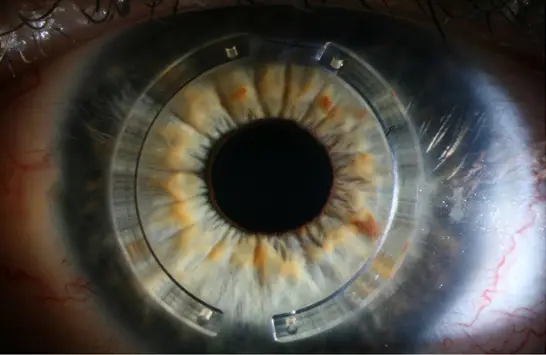
Intacs is a recent and revolutionary corneal ring prescription insert that is entirely reversible. Thus, patients who elect to have Intacs are not “locked in” to the procedure forever, as are patients who undergo other refractive procedures such as LASIK and PRK.

Vision correction with Intacs entails implanting the micro-thin intracorneal rings into the cornea by a trained eye surgeon. Intacs produce a reshaping of the curvature of the cornea, reliably reducing low degrees of myopia (nearsightedness). Intacs cannot be felt by the patient, require no maintenance, and are probably less visible than a contact lens to the naked eye. Intacs have been studied for 10 years and are FDA approved. The primary drawback at the present time is that Intacs are only available in the U.S. for low degrees of myopia (-1.00 to –3.00 diopters). However, these levels of myopia account for about 54% of all myopes.
Intacs are also prescription inserts, and they can be removed or replaced if one’s vision needs change or there is any dissatisfaction with the corneal ring inserts. In the U.S. clinical trials, all of the very few people who had Intacs removed could subsequently be corrected to 20/20 or better vision.
Intacs produce excellent results. In U.S. clinical studies, 97% of patients saw 20/40 or better, 74% saw 20/20 or better, and 53% saw 20/16 or better. Furthermore, placement of Intacs maintains the “normal” positive asphericity (shape) of the cornea whereas Excimer laser procedures such as LASIK and PRK frequently produce oblate corneas. The latter condition may result in reduced contrast sensitivity. Visual correction with Intacs is also rapid and stable. Eighty percent of patients have 20/40 or better vision the day after surgery. A year after surgery, over 50% of patients see 20/16 or better as a result of their first procedure, i.e., without enhancements.
Indications for Intacs
- -1.00 to ¬3.00 diopters of nearsightedness (myopia)
- (Note: this range of myopia is considered “mild” by EyeMDs, yet accounts for 54% of all myopes)
- Relative intolerance of glasses or contact lenses
- Properly motivated and realistic patient
Visual Results
Amazingly, 53% of patients see 20/16 or better as a result of their primary procedure and 34% see 20/20 or better the day after the procedure! One month after surgery 79% of patients see 20/25 or better and by one year 87% of patients see 20/25 or better. Fully 97% of patients are 20/40 or better one year following surgery (20/40 is a “benchmark” of visual acuity as this level of vision allows unrestricted passage of a driver’s license test in most states).
The Procedure
Intacs corneal ring prescription inserts are placed within the substance of the cornea under topically applied (eye drop) anesthesia. No needles or injections are required. Some patients may experience mild and temporary discomfort during the procedure. The surgeon makes a tiny incision in the top of the cornea, creates a 180 degree tunnel in which to place the first prescription insert, and then places the Intacs ring in the corneal tunnel. A similar procedure is used to place the second Intacs ring.
Two Intacs inserts are placed in each eye, each of which approximates a near half-circle. The tiny incision through which the Intacs are placed is usually closed with a single stitch that can be removed within a few days or weeks. The entire procedure usually takes about 15 to 20 minutes per eye.
What to Expect After Surgery
The day of surgery, the operated eye may feel somewhat scratchy and vision may be blurred. Do not be alarmed. Any discomfort will usually be relieved by anti-inflammatory eye drop medications. You will be instructed to use both antibiotic and steroid eye drops, generally for about two weeks following surgery. On the first postoperative day, vision is usually good enough to drive a car, i.e., 20/40 or better, but may be reduced if the eye remains dry or an abrasion of the corneal surface has occurred.
You will not be able to feel your Intacs inserts, however, you may feel the tiny incision and or stitch as the incision heals. This will usually resolve within a couple of days. If a suture was placed, your surgeon will probably remove it in about 2 to 4 weeks. With Intacs prescription inserts, you may expect your vision to recover very quickly and to continue to improve for up to 6 to 12 months.
Read More
Read More
Read More
Read More






